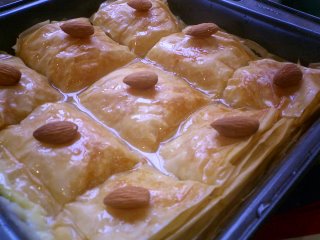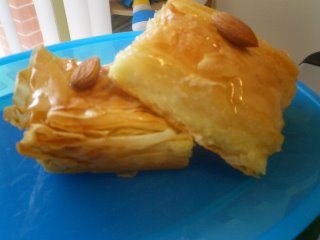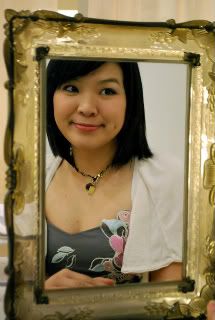 Bak-kla-a-va?
Bak-kla-a-va?I stumbled upon my pronunciation as I tried to read the tiny words on the label. It was my first month in Sydney about 2 years ago when I first heard and learnt of the Middle Eastern dessert. It was golden, sticky, messy and covered in pistachio.....didn't look too appealing from the display shelf, but I decided to have a go anyway. I asked the gentleman at the convenience store what it was; and he replied; "Lebanese sweet pastry, try, its good!". Any type of pastry couldn't be that bad I thought to myself as I took a bite. I wasn't disappointed. I bought a couple more flaky pastries and went on home to enjoy them. What I've learnt was that baklava isn't a dessert-type food which is eaten after a meal, but rather more of a snack to have with tea or coffee or just for entertaining guests with sweet treats.
I searched the internet for a brief history on the sweet and discovered interesting details from answers.com
It is believed that the Assyrians in the 8th century BCE were the first people in eastern Mediterranean that baked a mixture of chopped nuts and honey with dough, creating thus the predecessor to baklava. According to this theory, Greek seamen and merchants traveling east, soon discovered the delicacy and brought it back to Greece. The Greeks' major contribution to the development of this pastry was the creation of a technique that made it possible to roll dough as thin as a leaf, and thus wrap in multiple soft layers the chopped nuts. Trays of baklava, as we know it today, were being baked in every kitchen of wealthy households in the region, for all kinds of special occasions from the 3rd Century B.C.E. onwards.Muhallebili Baklava which I have made does not include nuts like the regular turkish type we find with pistachios. Muhallebili baklava is a Greek baklava which is covered in thin layers of pastry and filled with a smooth cream based semolina filling. Thanks to The Muffin-man for introducing me to this very interesting version of the Baklava.
20 layers filo pastry(cut to fit the square/rectangular cake tin) I used a square 9 inch
150gms melted butter
150gms melted butter
Filling:
2 cups milk
1/4 cups sugar
1/4 tsp salt
1/3 cups fine grain semolina
Syrup:
1/4 cups sugar
1/4 tsp salt
1/3 cups fine grain semolina
Syrup:
1 1/2 c sugar
1 cup water
2 tsp almond essence
Preheat oven to 350 F after the filling has been prepared.1 cup water
2 tsp almond essence
Divide the pastry into 2-equal parts. Lay 1 sheet on a well-buttered baking pan. Brush surface generously with melted butter. Lay second sheet on top of first and butter. Repeat until half of the pastry sheets have been used. Cover unused half of pastry sheets with a kitchen cloth to prevent from drying.
Prepare the filling: Over medium heat bring milk, sugar and salt to a boil in a saucepan. Add fine grain semolina by sprinkling in a little at a time, stirring constantly until the mixture thickens and the fine grain semolina is well cooked.
Spread the hot fine grain semolina mixture evenly over the entire surface of pastry sheets. Again build up the remaining half of the pastry sheets, buttering each surface generously. Pour the remaining butter over the top. Cut pastry sheets into equal serving squares. Bake for 40 to 45 minutes or until light golden.
While the baklava is in the oven. Stir syrup ingredients in a microwave safe bowl and microwave for 2 minutes stirring occasionally, till sugar has dissolved.
Remove baklava from the oven and brush on the syrup mixture until it is well absorbed. (I used only 3/4 of the syrup mixture as I didn't want it to be too sweet). Leave to dry for at least 2-3 hours to dry. (This part is the most difficult part! haha)
 The base recipe was from this website : LINK . However, I changed most of the proportions, removed the lemon juice and added almond essence instead to suit our liking. I didn't want too much sugar in it and I ran out of lemon juice. It turned out great with the almond flavour and It wasn't overwhelmingly sweet. Everyone thought it was delectable!
The base recipe was from this website : LINK . However, I changed most of the proportions, removed the lemon juice and added almond essence instead to suit our liking. I didn't want too much sugar in it and I ran out of lemon juice. It turned out great with the almond flavour and It wasn't overwhelmingly sweet. Everyone thought it was delectable!









6 comments:
YUMMY!!
That looks great! I wish I could cook:)
God Bless,
Diana Joy
wow another great recipe, that looks really good.
I'm very lucky to have a chef at work that makes really good baklava... it's been known to literally fly off the plates whenever she makes them.
Diana Joy : thanks :) cooking isn't difficult. A wise man once said to me, if you can read...you can cook! It just takes alot of practise sometimes.
Jen: thanks :) Have u tried her baklava? where do you work by the way?
That's called 'galaktoboureko' actually! It's only like baklava in that it's with phyllo dough ...
"Muhallebili baklava" is greek? oh my god you're so uneducated. Muhallebi means puding in turkish and Baklava is a turkish desert. Not greek. You say that it is a greek desert but the name of the desert is in turkish. IT IS A TURKİSH DESERT. BAKLAVA IS TURKİSH TRADİTİONAL DESERT.
she's not "uneducated" Serap. it is both greek and turkish. During the Empire of Trebizond (Pontus Rum İmparatorluğu), the turks in the black sea region (home of muhallebili baklava) and greeks exchanged many things; including traditional deserts. you don't usually hear about muhallebili baklava in turkish restaurants, but in europe and america greek restaurants keep it on their menu. so it is natural thet she thinks it is a greek desert.
...anyway it tastes great :)
Post a Comment